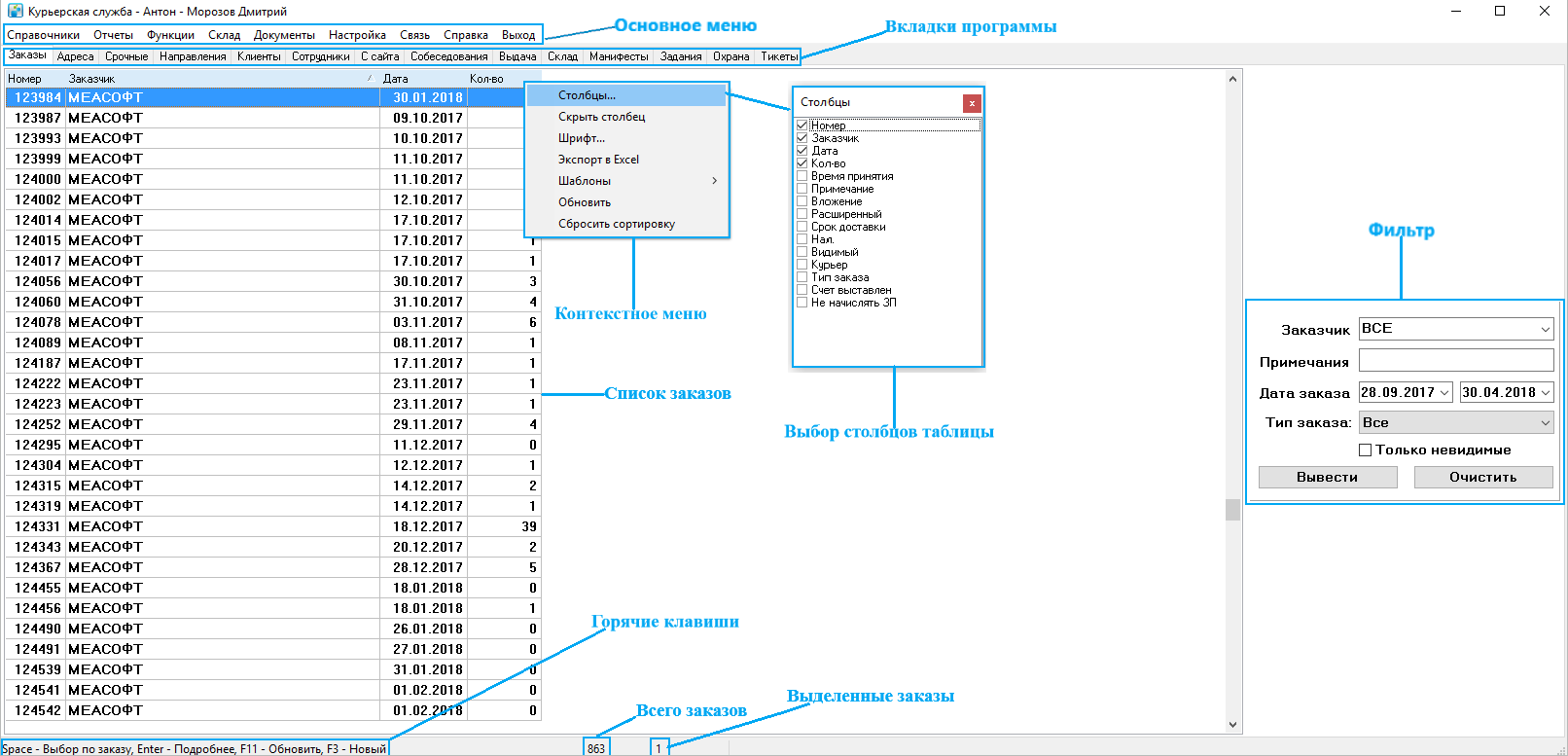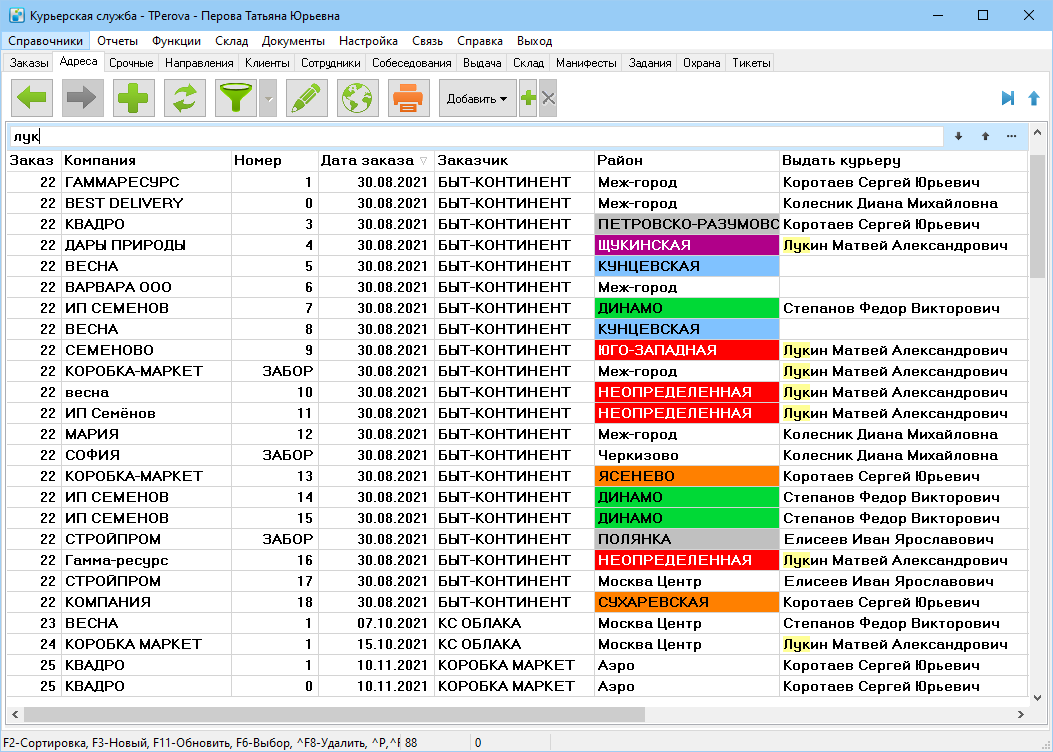Introduction to the system
Содержание
Purpose
The purpose of this section is to introduce you to the system's fundamental features.
Interface
Interface enables you to complete user tasks by establishing the «task - interface element» connection.
The system's default interface includes the main menu, tabs, tables,buttons and display filters.
Utilizing tables
You can change table columns by moving them around, arrange tables by column by clicking on the header, and modify table data using the context menu in any part of the application.
Sorting by:
- simple sorting by using a single column for ascending or descending order. Click on the column header once - to sort in ascending order, the second time - in descending order;
- multilevel sorting. For example, you must first sort by one column, then within this sort by another column, within the same sort by a third column, etc. To achieve this, first select the first column that has to be sorted on the left side of the screen. Next, while holding down the CTRL key, click the column headers in the appropriate order. To reset the sorting, select the Reset sorting header context menu item.
To reset the sorting, select the Reset sorting header context menu item.
The context menu on the table header offers the following options:
- Columns — View a list of all possible columns. To display a column in the table, check the box next to it. In the "Columns" window, through the context menu, you can select all columns, deselect all columns, sort by order or by name;
- Hide column — hide the current column;
- Font — adjust the font, size and color of the text;
- Export to Excel — export a table with the current display settings to a Microsoft Excel file. The user must have the right to «Export Shipments» (in the "Reports" node), to download tables from Addresses and Issue tabs and the right to «Export clients»to download data from the Clients tab;
- Templates — create a template with the required columns. For details, see the section «Utilizing templates»;
- Refresh — Refresh the data in the table. Tables on Employees, Clients and Orders tabs are updated automatically every 6 seconds. In other tables, the data may change (another user may enter information or data is received through integration), so they should be updated periodically;
- Reset Sorting — reset sorting. The option is active if the table was previously sorted by one or more columns.
Utilizing Templates
The templates let you build tables with a predetermined arrangement of columns for specialised tasks. To display the necessary columns, select Templates in the context menu, than select Save, after naming the template and clicking ОК.
To use a template, select the context menu Templates > Import and specify the template.
You can utilize table templates on the Addresses tab in the following ways:
- scheduling of local or intercity shipments;
- a template for a report's table. Save as a template after displaying the desired columns (such as "Date," "Weight," "Cost," etc.). The data from the resulting table is then uploaded to Microsoft Excel after the company for which the report is prepared has been filtered. Select the Export to Excel context menu item to do this.
To delete a template, choose Templates > Delete from the context menu of the column header and select the template to delete from the list.
Search for information
With the exception of Directions and Security, keyword search allows you to locate exact matches in the text and is available on all tabs. Press CTRL + F and type the search terms to conduct a search for information. On the tab, matches are highlighted:
You can use the arrows to move through the matches you find ![]() and
and ![]() or enter more specific search criteria with this button
or enter more specific search criteria with this button![]() .
Search criteria:
.
Search criteria:
- Search area — the area of the table where the search will take place. Possible values: Current column, Entire table;
- Case-sensitive — a case-sensitive search query is used to do the search;
- Whole words — the whole word must match the one entered;
- Starts with — The search query will be the first item in the search result.
Hotkeys
Keys or a combination of keys that allow you to perform an action. Hotkeys may not be active if the action they perform is blocked by user rights.
| General (applicable everywhere) | Addresses tab | Urgent tab |
|---|---|---|
| F1 — help (CTRL+F1 for the Urgent tab and shipment cards)
F3 — create ESC — close Enter — open F11 — refresh list CRTL+F8 — delete selected item CTRL+ALT+B — barcode reading simulation CTRL+P — print |
F1 — view order details F2 — sorting F4 — copy all addresses to Urgent F5 — enter delivery information and preview attached photos F6 — order filter F7 — generates a report on the sample for monetary tasks F8 — remove from selection F9 — opens a window for exporting a selection to Microsoft Excel with the ability to send information via e-mail CTRL+F1 — open client card CTRL+F3 — create a pickup slip from a selection CTRL+F12, CTRL+P — print slips/labels CTRL+ENTER (dblClick) — select by recipient company (select only addresses with the same recipient company) CTRL+S — show on map CTRL+M — add to a new manifest (opens manifest creation card) CTRL+T — accept work for tomorrow CTRL+O — select only selection CTRL+К — select by scheduled couriers (select only addresses scheduled for the same courier as the selected one) CTRL+SHIFT+F10 — payment for delivery by the sender (if the order is with cash payment, a payment card will open) BACKSPACE — previous selection SHIFT+BACKSPACE — next selection |
CTRL+F1 — help
CTRL+F9 — print table 7 — put down "?" in the courier 8 — show customer card + — put down "+" (in the case of a cash order, you must make a payment) - — put down "V" F1 — show a list of working couriers, orders by couriers F2 — show orders by customers F4 — decrease status F5 — increase status |
| Employees tab | Interviews tab | Tasks tab | Payments window |
|---|---|---|---|
| F9 — "Available Couriers" report | F9 — generate interview report | CTRL+F3 — create a new periodic task | CTRL+F3 — view link to invoices |
| Clients tab | Issue tab | Manifests tab | Orders tab | Invoices window |
|---|---|---|---|---|
| F2 — issue an invoice
F5 — post payment |
F5 — put delivery information in the shipment card
F12 — courier bonus/penalty CTRL+M — show on map CTRL+ENTER — select by recipient company (select only addresses with the recipient company, like the selected one) |
CTRL+M — print manifest
SHIFT+CTRL+M — print manifest 2 CTRL+R — profitability |
SPACE — open the addresses of the selected order | F5 — post payment
F9 — details CTRL+F9 — report on the amounts and dates of payment CTRL+F12 — dispatch |
Understanding Controls
In some fields and system forms, input simplifications are used:
- in the Date and Time type field, pressing the SPACE bar will put today's date and time according to the computer settings;
- in the Date type field you can enter a value in the "121022" form, the system brings this value to the commonly used date - 12.10.2022;
- in the employee selection fields, for example "Courier", you can move between the employee records with the PAGE UP and PAGE DOWN keys;
- you can set the number of columns in the menu. For example, if the courier service company has more than 220 couriers, then in the context menu Schedule for courier on the Addresses tab the entries are sorted alphabetically. Other menus in the system also sort in alphabetical order. To configure this, select the main menu item Setup > Options > Display > Group menu items if more than one and specify the number of items.
Sorting the list of addresses
- Sorting
- Ordering of data depending on the selected criterion.
You can use the following types of information sorting on the Addresses tab:
- by order and number - sorting is used by default when moving from Orders to Addresses. Recent orders are displayed at the top;
- by area — sorting inside the region is done alphabetically by receiver and by the arrangement of the subway stations and user created areas. These sorting results make all area orders apparent;
- by recipient company - arranging recipient companies in alphabetical order;
- by order and area — shipments from orders are sorted according to areas;
- by delivery time and area - sorting by two fields, orders with the shortest time left until the end of delivery will be displayed at the top, and division by areas is also used.
Manual sorting
This type of sorting is designed to manually change the order of orders on the Addresses tab. Manual sorting is enabled by the F2 key and is available in the following modes:
- by area;
- by the recipient company;
- by order and number;
- by order and area;
- by delivery time and area.
To switch between modes, press the F2 key.
For sorting modes where there is an area, an empty fixed column will be displayed on the left.
To move an order or a group of orders in the list, select one or more entries in the left column, then hold down the left mouse button and drag the entries to the top or bottom of the list.
The sequence order is preserved for the selected sorting mode.
Entering in address information
When determining the area, the system considers the text up to the first comma as a street, and between the first and second commas - the building number. The first search is made up by street and house number, and in the absence of such data - only by street.
When saving the shipment, the system also saves the relation of a particular street and a building number to the certain area.
This format of writing addresses is also used in the client and employee cards for Address field.
To enter an intercity delivery address, you must additionally specify the region or country and destination city. You can specify the destination city by postal code or manually select the recipient area in the drop-down list, then the recipient city from the drop-down list of cities. Please note that several towns can correspond to the same index and the system selects one of them at random, so you need to check the availability of the required town in the list of towns generated on the right.
If the desired locality is not on the list, tap ![]() and search for the locality by region and city/town name. There may be situations where one area may have several cities/towns with the same name, then they are combined in the system as one.
and search for the locality by region and city/town name. There may be situations where one area may have several cities/towns with the same name, then they are combined in the system as one.
To send a shipment to another country, enter the name of the country and city in English instead of the city. If the desired city does not exist, you can add it manually. After moderation, the city will appear in the system. For details, refer to «Cities».
Address guidlines
The system employs integration with KLADR и FIAS to enable address searches in current databases. Addresses from databases are automatically substituted in the shipment card’s recipient Recipient address field. The given address automatically determines the subway station.
Rules for filling in addresses:
| Rule | Example |
|---|---|
| The name of the street is written at the beginning. The word "building" or the abbreviation "b." when writing the address is not necessary. The entry format contains commas, spaces and periods. | 96 Wade Lane., 42/2a, building 1, apt. 50, blue door from 83 Abingdon Road. |
| Name qualifiers, such as "Big," "Small," "Lower," etc. (street), are condensed to one letter with a dot before the name itself is written all at once and without a space. | 51 G. Western Road., , building 6 |
| Ordinal numbers in street names are written before the street name with the ending incremented to one letter through a hyphen. | 9th Stroude Road, 9; 38th Gloddaeth Street., 2 |
| Street types are written in full, except: "street" - shortened to "street", "lane" - shortened to "lane." and "embankment" - to "emb." | 89 St James Boulevard, 23 p.10 |
| When the street has a historically established name that does not require an indication of the type | Amen Corner, 82 |
| When the street has a type, not officially indicated as a type | Cow shaft, 20 |
| A hyphen must be used when writing city names if they have it. | Saint-Petersburg (not Saint Petersburg) |
| If it's required to include the city in the address line, enter the name first, followed by "city," "village," etc. | Prominent city |
System buttons
![]() — print documents automatically filled out according to templates.
— print documents automatically filled out according to templates.
![]() — view and add attached documents.
— view and add attached documents.
![]() — view the messaging history (SMS, e-mail sent through the system).
— view the messaging history (SMS, e-mail sent through the system).
![]() — call via the system. If a contact has several numbers, you can select any of them. Skype or applications for IP telephony are used.
— call via the system. If a contact has several numbers, you can select any of them. Skype or applications for IP telephony are used.
![]() — send e-mail via the system. You can use Outlook and similar applications. You can work with templates.
— send e-mail via the system. You can use Outlook and similar applications. You can work with templates.
![]() — send SMS, you can use ready-made templates.
— send SMS, you can use ready-made templates.
![]() — an overview of the entire map. Allows you to see all shipment markers.
— an overview of the entire map. Allows you to see all shipment markers.
Go to quick start
This article is the first in the Quick start section. Click the button below to go to the next article.
|
Next step |



